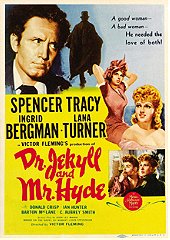You don’t go to MGM for horror, especially during the 1930s and 40s when Universal was cornering the market and RKO’s Val Lewton unit was making artistic works on shoestring budgets. MGM was the home of glamorous movie stars, of heightened romances, epics, and musicals. Yet here is 1941’s spin on Robert Louis Stevenson’s little Gothic novella about the duality of man, and what an odd creation it is.
MGM essentially took the script of the Pre-Code Paramount classic, gutted the stuff that wouldn’t get past the censors, and put big names squares into round holes. The entire thing takes the Gothic fervor and hothouse sensuality of the 1931 version, complete with similar shot setups, and plays it in the refined, glossy, sexless manner of many an MGM costume spectacle. The first thirty minutes and a couple of hallucination sequences feel like a cheat by the time Spencer Tracy’s Jekyll/Hyde finally meet their demise.
It all comes down to casting choices, muted story beats, and uninspired direction. Tracy is a baffling choice for the main role(s). His cinematic legacy is that of sturdy, good-natured all-American fathers, father figures, or individualists, so seeing him dive into a villain is an interesting prospect. It doesn’t come off through a combination of poor makeup (he resembles Dwight Frye during his manic scenes in Dracula), lazy acting (Hyde breathes roughly and bulges his eyes), and a lack of moments for him to play. By Tracy’s own admission he was miscast, and he worried that this film would torpedo his career. I mean, this is the film he chose to do in lieu of The Philadelphia Story.
While Ingrid Bergman does much better in general terms of acting, she’s sacked with a near unplayable role. Her character is clearly a sex worker but presented as a barmaid, and often swings back and forth between stubborn fighter and limp victim. This change happens within the same sentence in a few moments, and it could have been interesting material to dive into as Bergman’s character is clearly being beaten down and abused by Jekyll’s latent misogyny.
She’s the naughty whore to Lana Turner, of all people, as virginal bride-to-be. Turner’s legacy as a clotheshorse and less as an actress is underscored by her presence here as she evaporates from the memory as soon as she leaves a scene. If only the script had made room to explore how Jekyll’s love for Turner was entirely dependent on her virginity and social acceptability/societal status. It would have helped underscore the sexual violence of the Hyde persona as something always bubbling under the surface instead of coming out of the void as it does.
It’s not all gloom in this film as the first thirty minutes hint at a much better, psychologically complex film lying in wait. Look at the strange dream sequences during which Jekyll first turns into Hyde: Jekyll cracks the whip on horses pulling his carriage that transform into Bergman and Turner. Just as good is another sequence where Turner is trapped in a wine bottle with Bergman’s head as the cork that explodes once it is pulled out. These scenes are strange, sexually complicated, and way better than the rest of the overly long film orbiting around the two of them.
 Login
Login